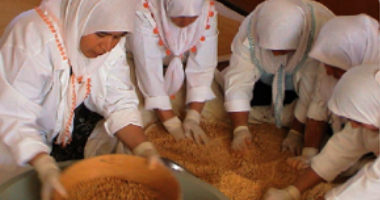Tarhana
As a fermented product tarhana is the dry form of yoghurt-cereal mixture and represents an important part of the diets of many people in Central Asia, Africa and Eastern Europe. It is prepared by mixing wheat flour, yoghurt, yeast and a variety of cooked vegetables (tomatoes, onions, green pepper etc.), salt, and spices (mint, paprika) followed by fermentation for one to seven days. Generally one part yoghurt is mixed with two parts of wheat flour.
The nutrient content of tarhana depends upon yoghurt and flour ratios as well as some other ingredients. It is also considered to be a useful high protein dietary supplement with average 15&proc; protein content. The addition of set yoghurt, due to high dry matter content and baker’s yeast, increases protein content and enhances its amino acid composition.
There are two traditional methods for tarhana making. The first method is called the straight method and ingredients in the recipe are mixed and kneaded, fermented, dried and finally sieved. The second method is called the sour dough method. It has three steps, each one has a different recipe. Throughout fermentation lactic acid bacteria and yeast give the characteristic taste and flavor of tarhana by producing lactic acid, ethanol, carbon dioxide and some other organic compounds. Organic acids composed in fermentation period lower the pH (3.4-4.2), and low moisture content (6-10%) is a poor medium for pathogens and spoilage organisms.
The third method involves the extrusion of the tarhana ingredients in a continuous and highly cost efficient extrusion process as used in HANSELAND’s production lines

